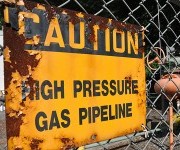The "natural gas revolution" has been kind of a disappointment. Yes, natural gas could help get us off of coal, and fast. But it has its own substantial environmental impacts, most of them stemming from the process of extracting it from the ground.
Now, though, a new "waterless" fracking method holds out the promise of natural gas without all the groundwater contamination and toxic wastewater. (It won't get rid of the noise or siting issues, however, which seem to be unavoidable when it comes to fracking.)
Here's how it works: A substance called Liquefied Petroleum Gas — basically, propane in liquid form — is pumped into the ground, instead of water. It cracks open the rocks where natural gas is trapped, and then both the LPG and the natural gas return to the surface. Unlike water, the LPG doesn't absorb heavy metals and then return them to the water supply. Fracking with LPG also uses substantially less fluid — one quarter as much, according to its inventor, Robert Lestz. (And it doesn’t use water at all, which is a big deal in drought-stricken areas.)
Lestz says that waterless fracking also gets more gas out of the same patch of ground than traditional hydrofracking, which is good news if you're hoping that natural gas will help get us off of coal and/or oil.


